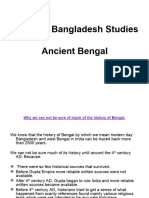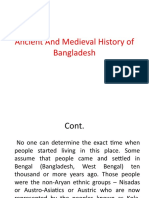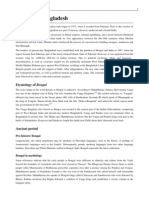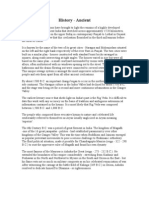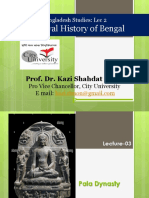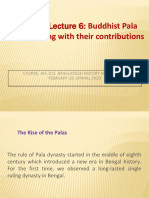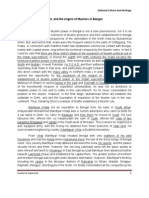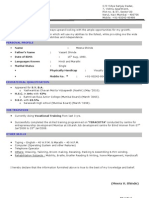NCH L-6 (Courtesy by Kaisar) - Suraiya Islam
NCH L-6 (Courtesy by Kaisar) - Suraiya Islam
Uploaded by
Md. Kaisar SyedCopyright:
Available Formats
NCH L-6 (Courtesy by Kaisar) - Suraiya Islam
NCH L-6 (Courtesy by Kaisar) - Suraiya Islam
Uploaded by
Md. Kaisar SyedOriginal Title
Copyright
Available Formats
Share this document
Did you find this document useful?
Is this content inappropriate?
Copyright:
Available Formats
NCH L-6 (Courtesy by Kaisar) - Suraiya Islam
NCH L-6 (Courtesy by Kaisar) - Suraiya Islam
Uploaded by
Md. Kaisar SyedCopyright:
Available Formats
L-6
National Culture And Heritage
The Earliest kingdoms and Empires:
The classical period - The Gupta period.
Ancient Bengal: It must be understood very clearly that Bengal or
Bangladesh a west Bengal in the ancient period had been one undivided Bengal, both
Eastern Bengal and west Bengal which was part of Eastern India. In order to know the
earliest history of Bangladesh it is important to know its earliest history in the Ancient
period.
In the ancient period Bengal was inhabited by different groups of people,
whose names were associated with the area who lived there permanently the people
i.e., the ‘Janapadas’ of pundra, Vanga, Radha and Gauda.
Pundra was roughly comprised of the territories of northern Bangladesh
and parts of north Bengal of the Indian province of west Bengal. Vanga denoted the
major portion of the present Bangladesh its Southern and South-Eastern districts.
Samatata was a unique important ‘Janapada’ in the Trans-Meghna region of
Bangladesh in the South-Eastern part of Comilla-Noakhali area. In fact, Chittagong with
its adjacent areas was known as Harikela. This fact came to be known from the later
Vedic literature. This area was inhabited by Non-Aryans i.e., the Dravidians; with its
capital at Ganje, a great market town on the banks of the Ganges, The evidence shows
that a great trade existed. North-Western part of Ancient India came under influence of
Aryans since the middle of the second millennium B.C., and it took a long time for the
Aryans to reach the eastern part of the sub-continent of India. So the people of Bengal
felt Aryanisation much later. From the 5th century B.C. the Aryan influence or the
Aryanisation took almost one thousand years to settle down deeply in the roots of the
entire Bengal. But before this Pre-Aryan influence the non-Aryan Characteristics and its
influence deeply affected the life and culture of the Bengali people. It is vital to note that
the “history of ancient Bengal from 4th century A.D. on wards, is the history of Aryan
dominate on both from the political as well as cultural”. Greek and Latin sources (3rd
century B.C.-1st century B.C.) refer to an eastern Indian nation as gangaridae (Greek),
and gangaridai (Latin) which was quite strong militarily.
Certainly, Pundranagar is regarded as the earliest urban administrative
and cultural centre throughout the ancient period up to the 12th century A.D. Scholars
have identified ‘Gangaridai’ located in parts of southern and southeastern Bengal, near
the mouth of the Ganges (Bhagirathi-Padma-rivers). Referring to other quantities of
ancient Bengal, the Arthasastra of kautiliya (3rd century B.C.) refers to fine cotton fabric
of Vanga (south-eastern Bengal). Historical evidences proved that Bengal was a
powerful kingdom and a great market town on the banks of Ganges Trade was between
Courtesy by: Kaisar Syed 1
L-6
National Culture And Heritage
Bengal and China and other countries. In fact, the name Vanga was also found among
the list of maritime countries where ships went for trade.
During the expansion of the Gupta rule under Samudra gupta in the 4th
century A.D. Bengal remained divided into independent states. But, most other
independent states gradually came under the rule of Samudra-Gupta. Samatata, the
Trans-Meghna region including Comilla-Noakhali was outside the Gupta rule. Samudra
Guptas son Chandra Gupta II considered samatata under the Gupta rule. By the end of
the 6th century A.D. Gupta authority was very strong and Gupta kings were known as
Kumara Gupta, Budha Gupta, Vaniya Gupta’s copper plates of the 5th century were
found in North Bengal which proved that there existed well established Gupta rule in this
area.
However, Bengal become an important province during this period and
was called “the golden Age” of Indian history. It is known historically that during this
period under the strong Gupta central government, there was peace, wealth and
prosperity for a long time. According to the Chinese visitor Fa-Hiwen’s account, Trade
and Commerce remarkably flourished in Bengal during this period. He also descried
that in the Eastern Tamralipta. (Modern Tamluk in Midnapur district of west Bengal) was
the great emporium of trade. The important factor is that the Gupta rule brought
religious toleration among their subjects. The imperial Gupta converted them to
Brahmanism and styled themselves as Parama bhaga vatas or Paramadaivates, but
surprisingly they also patronized Buddhism and gainism. The religious toleration
brought ultimately coexistence of religious beliefs. However, the artistic excellence of
the Gupta age is remarkable and had a great influence in artistic tradition of Bengal.
Indeed, the Gupta School inspired the Bengal school of sculptural art.
Sasanka the Gupta king:
Later Guptas had a long drown straggle between the Maukharis from the
central part of Northern India for the possession of Magadha (south Bihar) a dparts of
western and northern Bengal. By the beginning of the seventh century Gauda become
an independent kingdom under Sasanka. He was the first Gupta king who extended his
suzerain over the boundaries of Indian Empire. He was also regarded as the first
important king of Bengal who established his aggressive challenge and his supremacy
over northern India.
The Pala Dynasty:
The Pala dynasty was founded by Gopala in the middle of 8th century A.D.
and ruled Bengal for four centuries. The historian’s believed the rule of the Palas formed
the glorious period in ancient history of Bengal. This glorious history was contributed by
Courtesy by: Kaisar Syed 2
L-6
National Culture And Heritage
the combined effort of the eighteen generations of the Pala kings. They were (i) period
ascendency by Dharmapala (C.781-821 A.D.), Deva Pala (C. 821-861 A.D.), then
came a period of stagnation in the country (C. 861-995 A.D.). This was revived by Mahi
pala I (C. 995-1048 A.D.). Mahi pala 1 was regarded as the second founder of this
dynasty after the chaos in the country. The last phase (iii) period of Decline and
Disintegration was some how stopped by a strong rule of Rampala in (c. 1082-1124).
But Pala Empire did not last long. The final collapse came with the coming and rise in
power by the senas in the third quarter of the 12th century Aid. Both Mohipula I.
Dharmapula were powered enough to challenge the Gurjara prathiharas of western
India and Rshtakutas of southern India. There was a long drawn struggle for two
generations, but the Pala kings extended their boundaries of Bengal and Bihar as far as
Ranauj. In fast, Dharma Pala stands out most successfully in the annals of Pala dynasty
as a great conqueror and a brilliant leader who spread Bengal’s influence over North
India for quite sometime. We were a devout Buddhist, and remained a great Patron of
Buddhism and founded many famous monasteries. He also founded the monumental
architectural somapura Mahavira at Paharpur (in Naogaon in Bangladesh).This is
included in the ‘Heritage of Man’ of UNESCO and is regarded as the greatest Buddhist
Monastery in the Indian subcontinent, but the 2nd largest in the world.
From the 8 th century A.D. southeastern Bengal emerged as a big size and
strength under the Deva Dynasty with its capital at Deva parvata a city in the
Mainamati-Lalmai area. There were four generations of rulers from this dynasty. They
were known as Santideva, Viradeva, Anandadeva and Bhavadeva who ruled the
kingdom of Samatata while they were the contemporary of Pala kings. However, in the
9th century A.D. the kingdom of Herikela came into prominence, the area of Chittagong
to Comilla were included in the kingdom of Herikela. In fact, the Chandra’s followed the
Herikela rulers from the beginning of the 10th century A.D. Five generations of Chandra
rulers ruled for about 150 years (C. 900-1500 A.D.).They were (Trailoky Chandra, Sri
Chandra, Kalyana Chandra, Ladha Chandra and Govinda Chandra who ruled a huge
empire including Vanga and Samatata comprising Southeast and northeast of Sylhet
with their capital at Vikramapur in Munshiganj.
After the Chandra rule came the Varma Dynasty. This dynasty ruled for less than
a century. (C. 1080-1150 A.D.). The Verma rulers were Hindus and their capital was also
at Vikrampur. The Arab merchants and navigators had evidence between the 9th and 11th
century A.D. about the flourishing Sea Trade in the coastal area of south –eastern
Bengal specially through the parts of Arab’s ‘Samandar’ which is identified as
Chittagong port.
The Sena Dynasty:
Courtesy by: Kaisar Syed 3
L-6
National Culture And Heritage
By the end of the 12 th century A.D. Vijoy Sena founded this Sena Dynasty
into an empire. The Senas held the sway and position for more than a century (C. 1097-
1223 A.D.) in which Five generations of kings (Vijaysena, Vallala sena, Laksman
sena, Visvarupa Sena and Kesava sena) ruled. Just by this time, Muhammad
Bakhtiyar Khalji ended the Sena rule in western and northern Bengal in 1204 A.D.
whereas Laksmana sena had to look after his Southeastern Bengal, where his two sons
ruled for some time. It is surprising that, under the Senas, the whole of Bengal came
under a single rule. It is significant that Vikramapura which was the capital of the
Chandras and Varmans, continued to be the capital of the Sena as well.
The first three Sena kings of this dynasty Vijoy Sena (c. 1097-1160 A.D.),
Vallala Sena (c. 1160-1178 A.D.), and Laksmana sena (c. 1178-1206 A.D.) were very
important figures of the dynasty. The Sena rulers were Hindus, and their rule the fast,
was considered to be a period of revival of Hinduism in Bengal. Vallalasena, attempted
to establish an Orthodox Hinduism and Hindu social Order in Bengal. Therefore the
decline of Buddhism may be due to the fact that there was this change in social order.
The fact is that Buddhism received rude shock from the revival of Orthodox Hinduism by
the senas. It is rightly remarked by same one that, “It was not Islam which overcame
Buddhism, but a more jealous rival of nearer origin. “ It was really clear to see that
Buddhism become severely weak and broken well before the Muslims and Islam came
to Bengal permanently. I think, it is absolutely necessary to point out that Hindu
Orthodoxy towards other religious had a far reaching impact, indirectly to help the cause
of Islam in Bengal. The Sena period is also quite significant for the development of
Sanskrit literature in Bengal. It was partly the direct patronage of the sena kings and
partly to the environment created by them. For instance, one anthology “Sadukti
Karnamrita” stands out as a great works of poetical collection of the earlier as well as
of the sena periods, it contains 2370 poems composed by about 485 poets who
belonged to periods between 10th to 12th centuries A.D.
It is really noteworthy that 12th century Bengal under the senas witnessed
the great development of unprecedented flourishing of literary activities in Sanskrit and
eventually in Bengali.
Courtesy by: Kaisar Syed 4
You might also like
- History of BengalDocument21 pagesHistory of BengalSharmistha Talukder KhastagirNo ratings yet
- Sapta Vidha Anupapatti - Seven UntenablesDocument2 pagesSapta Vidha Anupapatti - Seven Untenablesraj100% (1)
- NCH L-6 (Courtesy by Kaisar Syed) - Suraiya IslamDocument4 pagesNCH L-6 (Courtesy by Kaisar Syed) - Suraiya IslamMd. Kaisar SyedNo ratings yet
- The Ancient BengalDocument13 pagesThe Ancient Bengalfaysal934ahmedNo ratings yet
- Lec 2 - Ancient and Medievel History PDFDocument12 pagesLec 2 - Ancient and Medievel History PDFSabbirNo ratings yet
- Ancient History of Bengal Lec - 02Document5 pagesAncient History of Bengal Lec - 02abdzawad00007No ratings yet
- History of BengalDocument43 pagesHistory of BengalMH AnîkNo ratings yet
- Assignment His103Document7 pagesAssignment His103Georgee78No ratings yet
- Final Section 1Document26 pagesFinal Section 1dd62gkkp5mNo ratings yet
- Ancient and Medieval History of BangladeshDocument37 pagesAncient and Medieval History of BangladeshMahfuzul saimonNo ratings yet
- History of Bangladesh Bangladesh EconomyDocument14 pagesHistory of Bangladesh Bangladesh EconomyAl Faruque0% (1)
- Lecture 2 - History of Ancient and Medieval BengalDocument11 pagesLecture 2 - History of Ancient and Medieval Bengaljns4kh6x9fNo ratings yet
- GED 111 Course Related ArticleDocument18 pagesGED 111 Course Related ArticleAshley M. BushNo ratings yet
- Ancient History of BangladeshDocument27 pagesAncient History of BangladeshimrulhacchanNo ratings yet
- The History of Independent Bengal From TDocument17 pagesThe History of Independent Bengal From TTabassum Tania SetuNo ratings yet
- BangladeshDocument78 pagesBangladeshidno1008No ratings yet
- Lecture 2 Part 2 Ancient BengalDocument26 pagesLecture 2 Part 2 Ancient BengalSinthia EvaNo ratings yet
- 11595-Marked-Pilot - Textbook - Paper1 - History-Converted-Bangladesh Studies BookDocument30 pages11595-Marked-Pilot - Textbook - Paper1 - History-Converted-Bangladesh Studies BookpopoutNo ratings yet
- Medieval PW Chap 1-2Document20 pagesMedieval PW Chap 1-2Ankit SachdevaNo ratings yet
- History of IndiaDocument7 pagesHistory of IndiaXaviery Keith NoconNo ratings yet
- Bangladesh Studies HistoryDocument90 pagesBangladesh Studies HistoryBlueNo ratings yet
- Reconstruction of Bengal's Pre-Muslim History (Main Notes)Document28 pagesReconstruction of Bengal's Pre-Muslim History (Main Notes)Adib ShaheenNo ratings yet
- OverviewDocument3 pagesOverviewapi-3737960No ratings yet
- Introduction AP History For All Appsc Exam OnlyDocument8 pagesIntroduction AP History For All Appsc Exam OnlyChintha SreenivasuluNo ratings yet
- DynastyDocument19 pagesDynastymrmahin429No ratings yet
- The Bengal Presidency: History and Rise of National MovementsDocument15 pagesThe Bengal Presidency: History and Rise of National MovementsAditya SinghNo ratings yet
- To Have An Idea of The Origin of The Name & Implications A Sub-Topic Has Been Considered As "VANGA OR BANGA"Document14 pagesTo Have An Idea of The Origin of The Name & Implications A Sub-Topic Has Been Considered As "VANGA OR BANGA"Kazi HabibaNo ratings yet
- Civilization 5Document5 pagesCivilization 5Brinzei LucianNo ratings yet
- Hindu - Buddhist DynastiesDocument49 pagesHindu - Buddhist DynastiesRafia Tasnim100% (1)
- History Timeline of BangladeshDocument12 pagesHistory Timeline of BangladeshLubna MariumNo ratings yet
- India Between Ad 750-1200Document12 pagesIndia Between Ad 750-1200Vaibhav Kumar Singh kalhans thakur kshatriyasNo ratings yet
- Ancient, Medieval & Muslim Period of BengalDocument21 pagesAncient, Medieval & Muslim Period of BengalAzmol HossainNo ratings yet
- Gupta Empire Upsc Notes 32Document4 pagesGupta Empire Upsc Notes 32William StainsNo ratings yet
- Ancient Bengal: Socio Political AspectsDocument16 pagesAncient Bengal: Socio Political AspectssufianNo ratings yet
- Lecture 2 The Political History of BangladeshDocument28 pagesLecture 2 The Political History of BangladeshSinthia EvaNo ratings yet
- Lecture-2 - Mediaval Bangla-Revised 8.12.23Document22 pagesLecture-2 - Mediaval Bangla-Revised 8.12.23Mohammad Mahin SarkarNo ratings yet
- EMB101 Notes 1Document24 pagesEMB101 Notes 1pandagirl5871No ratings yet
- Kingdom of Funan: by DR Uday DokrasDocument46 pagesKingdom of Funan: by DR Uday DokrasudayNo ratings yet
- Early Medieval IndiaDocument19 pagesEarly Medieval IndiaIndianhoshi HoshiNo ratings yet
- ARYANS To MUGHALSDocument1 pageARYANS To MUGHALSutshasharesNo ratings yet
- Teritories in AncientDocument21 pagesTeritories in AncientHassan Al MamunNo ratings yet
- Lec Sheet-1 Ancient Age in BengalDocument26 pagesLec Sheet-1 Ancient Age in BengalHulo BabaNo ratings yet
- Ancient 1Document18 pagesAncient 1akashraizada2023No ratings yet
- Medieval IndiaDocument4 pagesMedieval IndiaVijay kumarNo ratings yet
- The Ancient Period of BengalDocument26 pagesThe Ancient Period of BengalMH AnîkNo ratings yet
- Heritage of India: The Gupta EmpireDocument14 pagesHeritage of India: The Gupta EmpireSONI DEEKSHITHANo ratings yet
- History of Bengal: Ancient PeriodDocument26 pagesHistory of Bengal: Ancient PeriodMH AnîkNo ratings yet
- HIS 2172-Early MedievalDocument10 pagesHIS 2172-Early Medievalkaushal yadavNo ratings yet
- History India 13 To 26Document14 pagesHistory India 13 To 26VISHAL GUPTANo ratings yet
- History of Bangladesh (Ancient Period)Document26 pagesHistory of Bangladesh (Ancient Period)sumaya islam bably propriter100% (1)
- 07 - Chapter 2Document22 pages07 - Chapter 2Azimul Aktar BarbhuiyaNo ratings yet
- Classical and Early Medieval Periods of IndiaDocument17 pagesClassical and Early Medieval Periods of IndiaAchuuth KarthickNo ratings yet
- BUP-Bangladesh Studies-3Document26 pagesBUP-Bangladesh Studies-3merakiNo ratings yet
- West BengalDocument55 pagesWest BengalArti NareshNo ratings yet
- Class 8 - Lecture 6: Buddhist Pala: Dynasty Along With Their ContributionsDocument29 pagesClass 8 - Lecture 6: Buddhist Pala: Dynasty Along With Their ContributionsMahira MalihaNo ratings yet
- Early Medieval India History Notes 13Document4 pagesEarly Medieval India History Notes 13LeeluNo ratings yet
- Post Mauryan PeriodDocument22 pagesPost Mauryan PeriodSwarlatha PandeyNo ratings yet
- Ancient History of BangladeshDocument14 pagesAncient History of BangladeshFarahNo ratings yet
- Classical Period (C. 200 BCE - C. 650 CE)Document5 pagesClassical Period (C. 200 BCE - C. 650 CE)Rajashekar PrasadNo ratings yet
- BPH L-19 (Courtesy by Kaisar Syed) - Suraiya IslamDocument4 pagesBPH L-19 (Courtesy by Kaisar Syed) - Suraiya IslamMd. Kaisar SyedNo ratings yet
- Banglalink Operation & Maintenance (O&M) by KaisarDocument60 pagesBanglalink Operation & Maintenance (O&M) by KaisarMd. Kaisar SyedNo ratings yet
- BPH L-23 (Courtesy by Kaisar Syed) - Suraiya IslamDocument5 pagesBPH L-23 (Courtesy by Kaisar Syed) - Suraiya IslamMd. Kaisar SyedNo ratings yet
- BPH L-16 (Courtesy by Kaisar Syed) - Suraiya IslamDocument4 pagesBPH L-16 (Courtesy by Kaisar Syed) - Suraiya IslamMd. Kaisar SyedNo ratings yet
- NCH L-16 (Courtesy by Kaisar) - Suraiya IslamDocument3 pagesNCH L-16 (Courtesy by Kaisar) - Suraiya IslamMd. Kaisar SyedNo ratings yet
- NCH L-24 (Courtesy by Kaisar Syed) - Suraiya IslamDocument4 pagesNCH L-24 (Courtesy by Kaisar Syed) - Suraiya IslamMd. Kaisar SyedNo ratings yet
- Table of Contents For Banglalink Intern ReportDocument8 pagesTable of Contents For Banglalink Intern ReportMd. Kaisar SyedNo ratings yet
- NCH L-23 (Courtesy by Kaisar) - Suraiya IslamDocument5 pagesNCH L-23 (Courtesy by Kaisar) - Suraiya IslamMd. Kaisar SyedNo ratings yet
- NCH L-12 (Courtesy by Kaisar Syed) - Suraiya IslamDocument3 pagesNCH L-12 (Courtesy by Kaisar Syed) - Suraiya IslamMd. Kaisar SyedNo ratings yet
- NCH L-2 & 3 (Courtesy by Kaisar Syed) - Suraiya IslamDocument5 pagesNCH L-2 & 3 (Courtesy by Kaisar Syed) - Suraiya IslamMd. Kaisar SyedNo ratings yet
- NCH L-24 (Courtesy by Kaisar) - Suraiya IslamDocument4 pagesNCH L-24 (Courtesy by Kaisar) - Suraiya IslamMd. Kaisar SyedNo ratings yet
- NCH L-12 (Courtesy by Kaisar) - Suraiya IslamDocument3 pagesNCH L-12 (Courtesy by Kaisar) - Suraiya IslamMd. Kaisar SyedNo ratings yet
- NCH L-23 (Courtesy by Kaisar) - Suraiya IslamDocument5 pagesNCH L-23 (Courtesy by Kaisar) - Suraiya IslamMd. Kaisar SyedNo ratings yet
- NCH L-5 (Courtesy by Kaisar Syed) - Suraiya IslamDocument4 pagesNCH L-5 (Courtesy by Kaisar Syed) - Suraiya IslamMd. Kaisar SyedNo ratings yet
- NCH L-17 (Courtesy by Kaisar) - Suraiya IslamDocument4 pagesNCH L-17 (Courtesy by Kaisar) - Suraiya IslamMd. Kaisar SyedNo ratings yet
- NCH L-13 (Courtesy by Kaisar) - Suraiya IslamDocument2 pagesNCH L-13 (Courtesy by Kaisar) - Suraiya IslamMd. Kaisar SyedNo ratings yet
- NCH L-16 (Courtesy by Kaisar) - Suraiya IslamDocument3 pagesNCH L-16 (Courtesy by Kaisar) - Suraiya IslamMd. Kaisar SyedNo ratings yet
- NCH L-14 (Courtesy by Kaisar) - Suraiya IslamDocument3 pagesNCH L-14 (Courtesy by Kaisar) - Suraiya IslamMd. Kaisar SyedNo ratings yet
- NCH L-9 (Courtesy by Kaisar) - Suraiya IslamDocument2 pagesNCH L-9 (Courtesy by Kaisar) - Suraiya IslamMd. Kaisar SyedNo ratings yet
- NCH L-5 (Courtesy by Kaisar) - Suraiya IslamDocument4 pagesNCH L-5 (Courtesy by Kaisar) - Suraiya IslamMd. Kaisar SyedNo ratings yet
- NCH L-2 & 3 (Courtesy by Kaisar) - Suraiya IslamDocument5 pagesNCH L-2 & 3 (Courtesy by Kaisar) - Suraiya IslamMd. Kaisar SyedNo ratings yet
- NCH L-8 (Courtesy by Kaisar) - Suraiya IslamDocument4 pagesNCH L-8 (Courtesy by Kaisar) - Suraiya IslamMd. Kaisar SyedNo ratings yet
- B SC Nursing 3RD Nov 23Document53 pagesB SC Nursing 3RD Nov 23Deepanshu KumarNo ratings yet
- Corporates 33Document1,578 pagesCorporates 33venkatesh_1829100% (2)
- B.E. Mirit List 14.Pdf - 1Document1 pageB.E. Mirit List 14.Pdf - 1Ajinkya DeshpandeNo ratings yet
- MoolamDocument1 pageMoolammukeshysNo ratings yet
- HSC Exam List 2024Document68 pagesHSC Exam List 2024chadonis777No ratings yet
- A. The Writer's Trip To YogyakartaDocument3 pagesA. The Writer's Trip To Yogyakartatumbal satuNo ratings yet
- 1 - Section and Faculty ListDocument41 pages1 - Section and Faculty ListSunil VashisthNo ratings yet
- Sub:Risk Assumption Letter: Insured Vehicles DetailsDocument4 pagesSub:Risk Assumption Letter: Insured Vehicles DetailskamleshyadavmoneyNo ratings yet
- MeeraDocument2 pagesMeeramegha4331No ratings yet
- HAMMER AND TOOLKIT 10 Oct ResultDocument1 pageHAMMER AND TOOLKIT 10 Oct Resultajaywork686No ratings yet
- Today's Fallen Heroes Friday 1 November 1918 (1568)Document32 pagesToday's Fallen Heroes Friday 1 November 1918 (1568)MickTierneyNo ratings yet
- GFRDDocument9 pagesGFRDLalit NagarNo ratings yet
- Maharana PratapDocument3 pagesMaharana PratapValeria Burgos100% (1)
- Telephone Directory Haryana 2017 - Abhishek KadyanDocument48 pagesTelephone Directory Haryana 2017 - Abhishek KadyanNaresh KadyanNo ratings yet
- ProvisionalDocument17 pagesProvisionalVishalNo ratings yet
- Lingaya's University: Examination Cell Marks Statement of B.Tech II Year Term - VI Examinatioins (Session: 2010-11)Document4 pagesLingaya's University: Examination Cell Marks Statement of B.Tech II Year Term - VI Examinatioins (Session: 2010-11)Mayank SharmaNo ratings yet
- Draft Deed of Conveyance - FlatDocument24 pagesDraft Deed of Conveyance - FlatIndranil Roy ChoudhuriNo ratings yet
- Important ReadingsDocument4 pagesImportant ReadingsUnnayan ChandraNo ratings yet
- Dell Exclusive StoreDocument5 pagesDell Exclusive Storerkpatel40No ratings yet
- Samples 1Document6 pagesSamples 1dpkrajaNo ratings yet
- Local PaymentDocument54 pagesLocal PaymentTanishque LohiaNo ratings yet
- Chandigarh - The City BeautifulDocument14 pagesChandigarh - The City BeautifulAmit GurjarNo ratings yet
- DAta For Calling PDF Cinema of India 6Document1 pageDAta For Calling PDF Cinema of India 6shivaparmarbhounraNo ratings yet
- Admission Committee For Professional Courses, Ahmedabad 380015Document5 pagesAdmission Committee For Professional Courses, Ahmedabad 380015VISHNU PANDEYNo ratings yet
- Brand New Tax FreeDocument15 pagesBrand New Tax Freeprarooptrigunayat12No ratings yet
- Sbi EdcDocument201 pagesSbi EdcSneha AdepuNo ratings yet
- MalvanDocument24 pagesMalvanmaheshparab196555No ratings yet
- Bhatti Rajputs Early HistoryDocument31 pagesBhatti Rajputs Early HistoryAhmad Raja50% (2)
- A Sad Hy Arogan Ivar An A MantraDocument9 pagesA Sad Hy Arogan Ivar An A MantraKrishNo ratings yet



